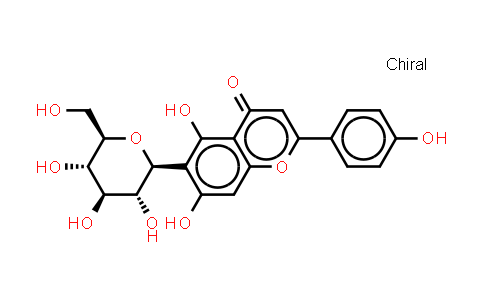| Chemical Name |
Isovitexin |
| CAS Number |
38953-85-4 |
| MDL Number |
MFCD00076044 |
| Molecular Formula |
C21H20O10 |
| Molecular Weight |
432.38 |
| Synonyms |
Saponaretin;Homovitexin |
Introduction of 38953-85-4 :
Isovitexin is a flavonoid isolated from rice hulls of Oryza sativa, possesses anti-inflammatory and anti-oxidant activities; Isovitexin acts like a JNK1/2 inhibitor and inhibits the activation of NF-κB. IC50 & Target: JNK1/2, NF-κB[1] In Vitro: Isovitexin protects against LPS-induced oxidative damage by suppressing intracellular ROS generation, and also attenuates the effect of H2O2 on cell viability. Isovitexin (0-100 μg/mL) with LPS (2 μg/mL) is not cytotoxic to RAW 264.7 cells, but 200 μg/mL Isovitexin shows significant cytotoxicity. Isovitexin (25, 50 μg/mL) inhibits LPS-induced increases in TNF-α, IL-6, iNOS, and COX-2 levels. Isovitexin (25, 50 μg/mL) also suppresses the IκBα phosphorylation and degradation in RAW 264.7 cells, and such an effect is consistent with that of JNK1/2 inhibitor[1]. In Vivo: Isovitexin (50 and 100 mg/kg, i.p.) causes less severe histopathological changes in the lung sections, and reduces inflammatory cell count in LPS-induced mice. Isovitexin (50 and 100 mg/kg, i.p.) protects against LPS-induced inflammation and oxidative stress in LPS-induced ALI mice by decreasing TNF-α and IL-6 production, ROS generation, and MPO and MDA content, increasing SOD and GSH levels and effectively inhibiting the protein expression of iNOS and COX-2[1]. Isovitexin (25, 50, 100 mg/kg) dose-dependently reduces the survival rate of LPS/D-gal induced hepatic injury in mice. Isovitexin also inhibits NF-κB activation and up-regulates Nrf2 and HO-1 induced by LPS/D-gal in mice[2].
| Purity |
NLT 98% |
| Storage |
at 20ºC 2 years |
*The above information is for reference only.
